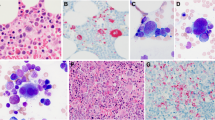Abstract
In line with the view that aneuploidy destabilizes the karyotype, initiating an autocatalytic process that gives rise to further loss and/or gain of chromosomes, we examined whether a constitutional aneuploidy such as monosomy for one chromosome is associated with sporadic loss and/or gain of other chromosomes. We used PHA-stimulated lymphocytes from eight women with Turner's syndrome (six displayed X chromosome monosomy ranging from 60.2% to 97.9%, and two were below 10%), and eight healthy women who served as a control group. Fluorescence in-situ hybridization (FISH), applied at interphase, was used to evaluate the level of aneuploidy for three randomly selected chromosomes (autosomes 8, 15 and 18) in each sample. For each tested chromosome, our results showed a significantly higher level of aneuploid cells in the samples from patients than in those from controls (p < 0.01). The mean level of aneuploid cells for all three tested autosomes was almost twice as high in the patient samples as in the control samples (p < 0.002). It is noteworthy that, in the Turner's syndrome patients, X chromosome disomic cells also displayed increased levels of aneuploidy. It is possible that monosomy of X chromosome in female cells destabilizes their own genome and also affects X disomic cells in the region. One may also speculate that a common factor(s) is involved with both constitutional and sporadic aneuploidy.
Similar content being viewed by others
References
Amiel A, Avivi L, Gaber E, Fejgin MD (1998) Asynchronous replication of allelic loci in Down syndrome. Eur J Hum Genet 6: 359–364.
Amiel A, Korenstein A, Gaber E, Avivi L (1999) Asynchronous replication of alleles in genomes carrying an extra autosome. Eur J Hum Genet 7: 223–230.
Antonarakis SE, Lyle R, Dermitzakis ET, Rymond A, Deutsch S (2004) Chromosome 21 and Down syndrome: from genomics to pathophysiology. Nat Rev Genet 5: 725–738.
Bean CJ, Hunt PA, Millie EA, Hassold TJ (2001) Analysis of malsegregating mouse Y chromosome: evidence that the earliest cleavage divisions of the mammalian embryo are non-disjunction prone. Hum Mol Genet 10: 963–972.
Blatt J, Olshan AF, Lee PA, Ross JL (1997) Neuroblastoma and related tumors in Turner’s syndrome. J Pediatr 131: 666–670.
Carrel L, Willard HF (2005) X-Inactivation profile reveals extensive variability in X-linked gene expression in females. Nature 434: 400–404.
Carrel L, Cottle AA, Goglin KC Willard HF (1999) A first-generation X-inactivation profile of the human X chromosome. Proc Natl Acad Sci USA 96: 14440–14444.
DeBrasi D, Genardi M, D’Agostino A et al. (1995) Double autosomal/gonosomal mosaic aneuploidy: study of nondisjunction in two cases with trisomy 8. Hum Genet 95: 519–525.
Dobie KW, Hari KL, Maggert KA, Karpen GH (1999) Centromere proteins and chromosome inheritance: a complex affair. Curr Opin Genet Dev 9: 206–217.
Duesberg P, Li R (2003) Multistep carcinogenesis – a chain reaction of aneuploidization. Cell Cycle 2: 202–210.
Duesberg P, Rasnick D (2000) Aneuploidy, the somatic mutation that makes cancer a species of its own. Cell Motil Cytoskelet 47: 81–107.
Eastmond DA, Pinkel D (1990) Detection of aneuploidy and aneuploidy-inducing agents in human lymphocytes using fluorescence in situ hybridization with chromosome-specific probes. Mutat Res 234: 303–318.
Gravholt CH, Juul S, Naeraa RW, Hansen J (1998) Morbidity in Turner syndrome. J Clin Epidemiol 51: 147–158.
Harada N, Abe K, Nishimura T et al. (1998) Origin and mechanism of formation of 45,X/47,XX,+21 mosaicism in a fetus. Am J Med Genet 75: 432–437.
Hasle H, Olsen JH, Nielsen J, Hansen J, Friedrich U, Tommerup N (1996) Occurrence of cancer in women with Turner syndrome. Br J Cancer 73: 1156–1159.
Hassold T, Hunt P (2001) To err (meiotically) is human: the genesis of human aneuploidy. Nat Rev Genet 2: 280–291.
Hassold TJ, Pettay D, Robinson A, Uchida I (1992) Molecular studies of prenatal origin and mosaicism in 45,X-conceptuses. Hum Genet 89: 647–652.
Jacobs PA (1990) The role of chromosome abnormalities in reproductive failure. Reprod Nutr Dev Suppl 1: 63S–74S.
Jacobs PA, Hassold TJ (1995) The origin of numerical chromosome abnormalities. Adv Genet 33: 101–133.
Lorda-Sanchez I, Binkert F, Maechler M, Schinzel A (1992) Molecular study of 45,X conceptuses: correlation with clinical findings. Am J Med Genet 42: 487–490.
Mukherjee AB, Thomas S (1997) A longitudinal study of human age-related chromosomal analysis in skin fibroblasts. Exp Cell Res 235: 161–169.
Pidoux AL, Allshire RC (2000) Centromeres: getting a grip of chromosome. Curr Opin Cell Biol 12: 308–319.
Rasnick D (2002) Aneuoloidy theory explains tumor formation, the absence of immune surveillance, and the failure of chemotherapy. Cancer Genet Cytogenet 136: 66–72.
Reish O, Gal R, Gaber E, Sher C, Bistritzer T, Amiel A (2002) Asynchronous replication of biallelically expressed loci: a new phenomenon in Turner syndrome. Genet Med 4: 439–443.
Schubert R, Eggermann T, Hofstaetter C, Netzer BV, Knöpfle G, Schwanitz G (2002) Clinical, cytogenetic, and molecular findings in 45,X/47,XX,+18 mosaicism: clinical report and review of the literature. Am J Med Genet 110: 278–282.
Shapiro BL (1983) Down syndrome: a disruption of homeostasis. Am J Med Genet 14: 241–269.
Shi Q, King RW (2005) Chromosome nondisjunction yields tetraploid rather than aneuploid cells in human cell lines. Nature 13: 1038–1042.
Zinn AR, Page DC, Fisher EMC (1993) Turner syndrome: the case of the missing sex chromosome. Trends Genet 9: 90–97.
Author information
Authors and Affiliations
Corresponding author
Rights and permissions
About this article
Cite this article
Reish, O., Brosh, N., Gobazov, R. et al. Sporadic aneuploidy in PHA-stimulated lymphocytes of Turner’s syndrome patients. Chromosome Res 14, 527–534 (2006). https://doi.org/10.1007/s10577-006-1050-9
Received:
Revised:
Accepted:
Published:
Issue Date:
DOI: https://doi.org/10.1007/s10577-006-1050-9




